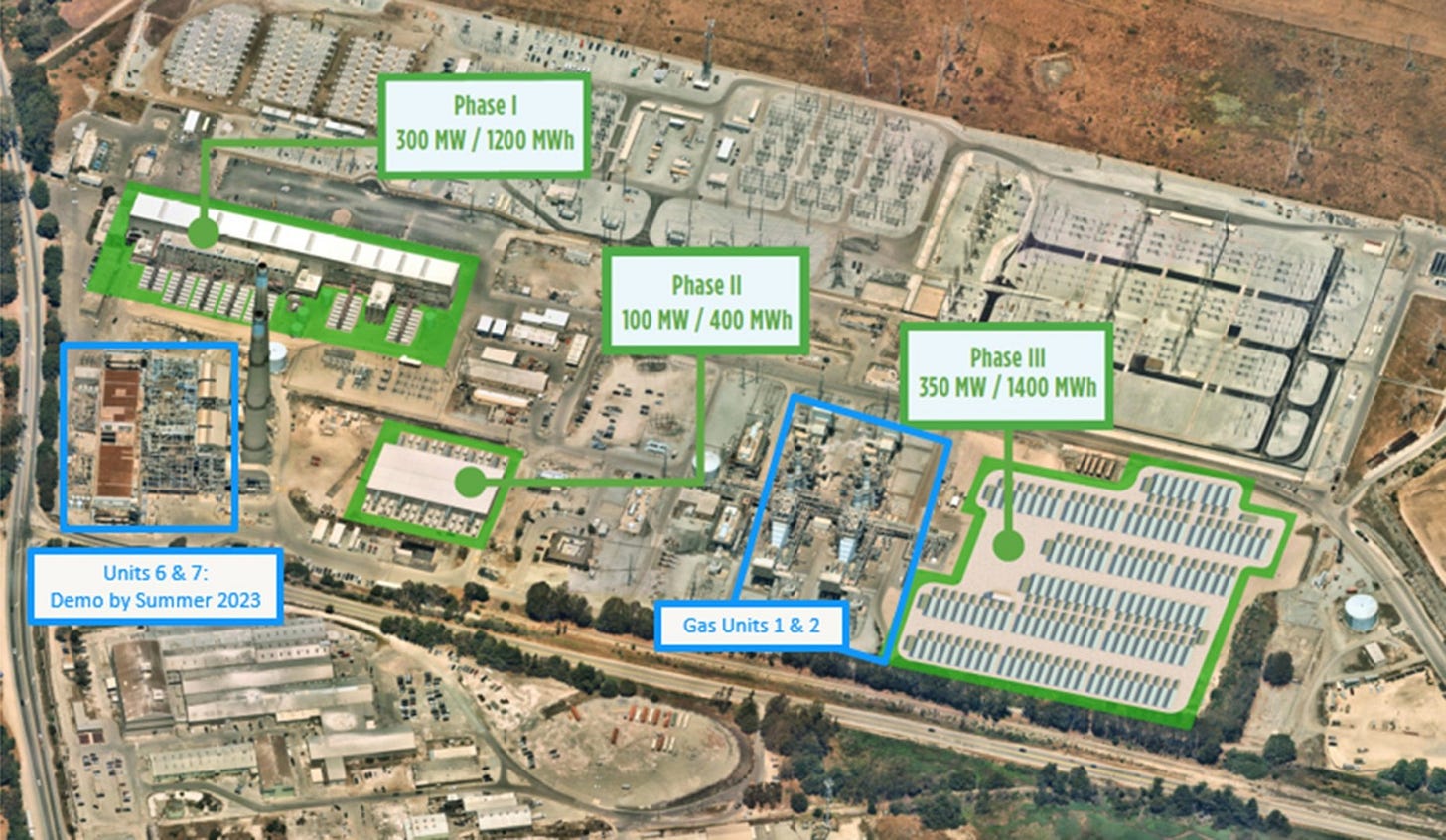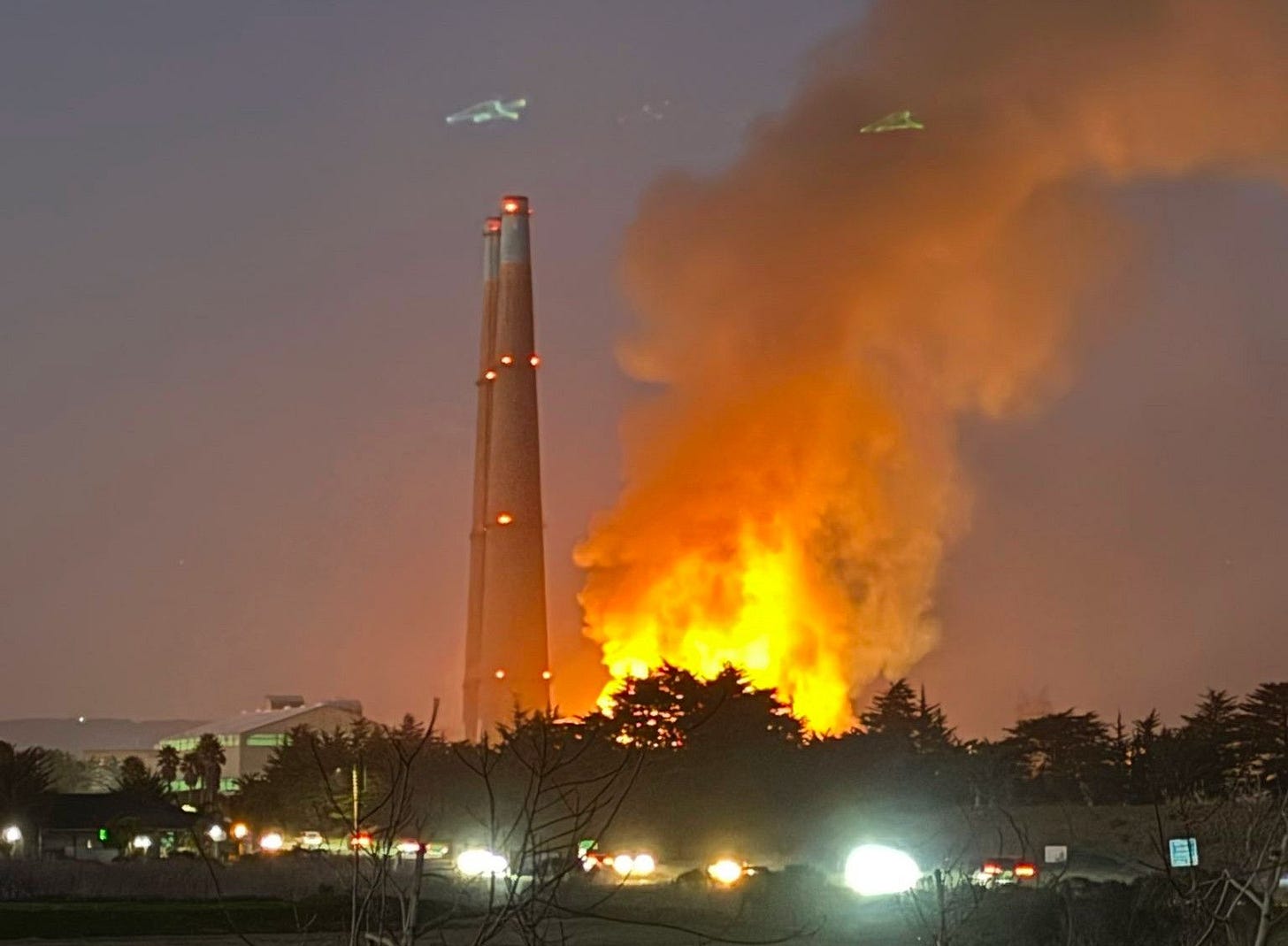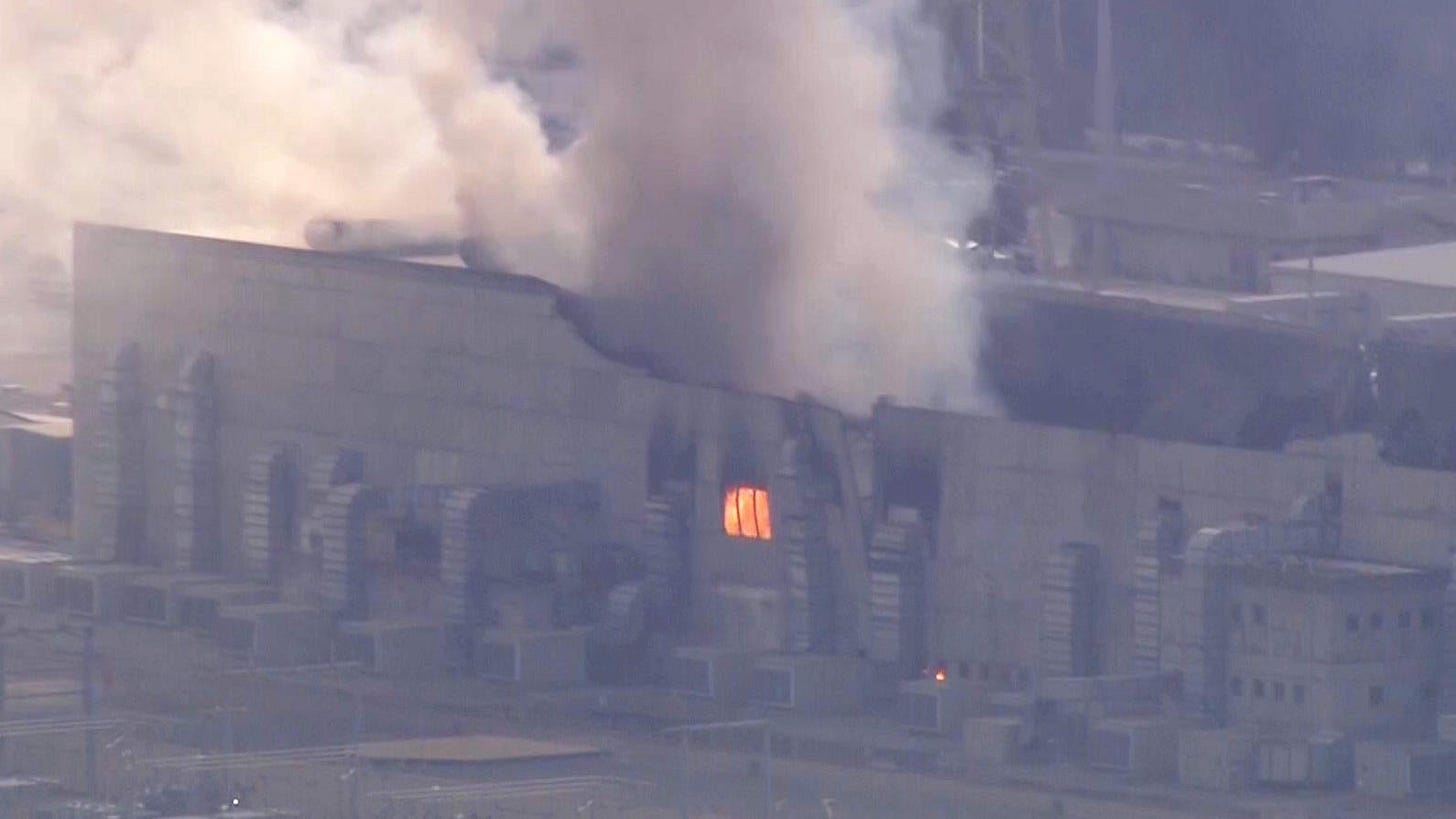A Net-Zero Chernobyl: California Battery Fire Releases Tons of Carcinogenic Metals and Toxic Gases
Toxic materials blanket communities, farms, and a sensitive estuary
Above: Stunning time-lapse video footage on YouTube.
Tuco’s Child Preface
Dear Readers, we recently shared an article describing the dangers of lithium ion batteries in terms of fire and catastrophic thermal runaway, and the dangers EVs pose to the general public and property.
Excerpt from EV Infernos:
When one or more battery cells are damaged or abused, the resulting heat can affect the battery cells adjacent to the first, causing a cascading failure mode.
When the cells cook-off, an EV fire may burn as high as 5,000 degrees Fahrenheit (2,760 Celsius). In contrast, a gasoline-powered vehicle fire burns at 1,500 F (815 C). The high temperatures realized in a lithium battery fire can cause EV structural metals such as aluminum, iron, and copper to melt.
Looking up the properties of metals used in an EV, one will find that the melting point of aluminum is 660 C, with copper at 1084 C, and steel at about 1425 - 1540 C. These metals may melt, pool, and/or vaporize in and around a lithium fire.
In a typical scenario, a battery explosion from gas pocket ignition and failure of the battery case results in the high velocity ejection of hazardous molten metals, like volcanic lava being ejected from Mt.Vesuvius.
Above: thermal runaway means just that - runaway!
The subject of lithium batteries continues to interest me, post my career as a product development engineer at Raychem, where I focused on lithium battery circuit protection.
A Net-Zero Chernobyl: the Vistra Moss Landing Battery Fire
In this article, Gene Nelson, PhD of GreenNuke and I will examine the toxic materials released from the Vistra Corp Moss Landing battery fire and present estimates on the amount of the toxic materials broadcast over adjacent areas by the fire.
What spurred us to look further was the initial lack of information about the extent of the toxics released from the fire, followed by a recent press release from a local scientist who sampled soil from the areas around Moss Landing, which includes a fishing port, farm communities, and an environmentally sensitive estuary.
Above: California Dreaming until it isn’t. Surrounding the Moss Landing power plant are sensitive biosystems, a fishing port, and farming communities.
Tons of Battery Materials Vaporized
Background. The Moss Landing site is home to two separately owned battery energy storage systems (BESS): PG&E's Elkhorn system, and Vistra's Moss Landing systems (Phase I, II, and III).
In 2023, Vistra completed the 350-megawatt/1,400-megawatt-hour Phase III expansion of its Moss Landing Energy Storage Facility, bringing its total capacity to 750 MW/3,000 MWh. It is thought that the Moss Landing BESS is (or was) the largest in the world.
Above: Overview of the plant. Phase 1 just burned. Note proximity of PG&E gas unit.
Above: racks of LG lithium nickel manganese cobalt (NMC) batteries in the Moss Landing Phase 1 building that burned. NMC batteries have lower thermal runaway thresholds and will burn hotter than other battery chemistries.
Tons of Batteries Vaporized. Vistra's 300 MW/1200 MWh Phase I BESS caught fire on January 16th, 2025. Firefighters used a "monitor and contain" approach and allowed the fire to burn itself out, as there was no way to control it safely. This was not the first fire, as the Phase I Vistra system experienced an incident in 2021 and came back online in 2022. The plant has a checkered past shall we say.
It is important to note that lithium NMC battery fires rage at about 2760 degrees Celsius, thus easily vaporizing metallic and nonmetal battery components and even adjacent structural materials, such as battery racks and other items made out of steel and aluminum, and the building itself.
Gene and I were particularly interested in just how much (mass) of the Moss Landing battery materials “went up in smoke” due to the battery conflagration. A cursory literature search of prior lab data uncovered a number of references indicating that up to, or even exceeding 50 % loss of battery mass is not uncommon for these thermal runaway incidents. The battery mass lost includes liquid electrolyte, anode, cathode, and battery structural materials.
The state of charge (SOC) of the batteries that burn is of critical importance. If a battery has been fully charged and is thus full of potential energy, the fire and thermal runaway will be the most violent (exothermic), in contrast to a partially charged battery.
Calculations for Tons of Batteries Vaporized. The Phase 1 Moss Landing BESS aka MOSS 300 uses the LG TR1300 system comprising 3,247 modules. As shown below, we use data supplied by LG and Vistra to calculate battery mass loss due to the fire. We also assume that 80 % of the battery is destroyed.
From these data we calculate that on the low-low end, a 10 % fire mass loss results in the loss of about 600,000 kg of battery material or about 600 metric tons. On the higher end, a 50 % fire mass loss is about 3 million kilograms of battery materials or 3000 metric tons.
Above: spreadsheet used data from Vistra and LG to calculate the battery mass loss of fully charged batteries. Tons above are metric tons.
Environmental Toxicity. Given the many tons of batteries utilized at the ML electricity battery storage plant, the violence of the inferno, and the massive plumes of smoke exuded, common sense would dictate that the vaporized battery materials could be broadcast over the significant areas and distances of which the smoke traveled.
Above: Some people at first wondered if it was a launch of Space-X from a new location.
As noted, Vistra's Moss Landing BESS batteries comprise the metallic elements lithium, cobalt, manganese and nickel, organic electrolyte, as well as fluorinated polymer membrane materials. When the batteries burn, the lithium oxides are not the worry, but rather the fine particulates of the toxic heavier metal elements, and the corrosive hydrogen flouride gas and other toxic fluoride compounds.
It has been reported by many researchers in the peer reviewed literature that the metal particles dispersed from the battery fires are very fine particulates, from extremely toxic nanoparticles to larger micron sized particles. One such article discussing particle size distributions and mass loss is found here and here with numerous cited and citing references. Nanoparticles are extremely small (0.000000001 meters) and can be orders of magnitude more toxic than larger micron-sized particles, depending on the material. This is because the extremely tiny particles by nature are more chemically active and easily stick to and integrate with tissues and even DNA 🧬.
The median lethal dose, or LD50, is a term used in toxicology as a measurement of a lethal dose of a substance (e.g., pathogen, medication, toxic substance, etc.). Specifically, the LD50 represents the dose at which a substance is lethal for 50% of tested subjects. The LD50 is well described for cobalt, manganese and nickel bulk metals and large micron sized particles, but nanoparticles can show extreme non-linear toxicity in comparison to bulk material and larger diameter powders. One review on the subject is: Toxicity of metal-based nanoparticles: Challenges in the nano era.
For miles around Moss Landing, high levels of potentially carcinogenic metal particle contamination were found by a respected scientist from San Jose State University. Metal contaminant levels were found to be 100s or 1000s of times higher than normal per the following quote from Monterey County and reprinted initial report below.
According to a press release from SJSU, unusually high concentrations of nickel, manganese and cobalt were detected by the university's Moss Landing Marine Laboratories by scientist Ivano Aiello, Chair of the Geological Oceanography Department. The heavy metals were seen in soils within two miles of the fire which burned for five days and resulted in evacuations, road closures and health concerns.
Above: burning Phase 1 hulk ala Chernobyl.
Tax Credits for Building the Battery Storage Plant
So called renewables and green energy projects have been vigorously supported by the previous administration and your tax dollars via the Inflation Reduction Act (IRA) and other means.
In my quest to discover how taxpayer dollars and incentives supported the Vistra Moss Landing battery storage facility, I consulted my co-author, Dr. Gene Nelson who directed me to Investment Tax Credit and Production Tax Credit section of the Inflation Reduction Act (IRA). The IRA allows for tax credits for “Grid-scale Battery Electric Storage Systems (BESS) and Distributed BESS” of which the Vistra Corp Moss Landing (ML) battery facility is.
We surmise that it is highly likely that the Vistra Moss Landing battery storage facility is and has been supported by taxpayer dollars via tax credits in some way shape or form, but have no absolute proof. The pdf of IRA provisions related to Grid-scale Battery Electric Storage Systems (BESS) is found below.
Above: pdf describing IRA provisions for large scale battery storage facilities.
Conclusions and Not in My Backyard
Net-zero policies typically end up doing more harm than good. The Vistra Corp Moss Landing battery fire is a modern Net-Zero Chernobyl, as many tons of toxic and carcinogenic materials were broadcast over large areas including farms and sensitive biosystems. The effects are unknown. Perhaps the toxic metals will be diluted and washed away without harm, or maybe they will enter the ecosystem and do damage to people and the creatures that inhabit the land, estuary and ocean. Local residents are now protesting the location of such facilities near sensitive areas and neighborhoods with good reason.
Finally, one has to ask oneself:
Given the choice, would I live next to a fireworks manufacturing plant, a Nobel TNT manufacturing plant or a grid-scale battery electric storage facility?
Pray for NO Rain
One final-final note: if it rains during a lithium battery fire, the fire could get worse as lithium violently reacts with water to create explosive hydrogen gas.
Additional Media
Special thanks to Dr. Jeff Bonnano of the Albert Einstein College of Medicine for his editorial help.




















To summarize, somewhere between 0.6 and 3.0 million metric tons of batteries went up in smoke from this single conflagration.
Per a 24 February 2025 Underwriter's Laboratory newsletter, 80% of the NMC lithium-ion batteries in the Moss Landing turbine hall were destroyed. https://fsri.org/news/moss-landing-battery-fire-hit-plant-older-vulnerable-technology
The total cost of those batteries was about $400 million. In addition, there are the costs of nearby businesses having to close, the cost of firefighting, and the cost of removing the charred remains of the batteries, which are hazardous material. The current total estimate is about $360 million. The Monterey Herald published an informative article with several photographs on June 12, 2022 with the title, "Energy storage in Moss Landing: A smoky challenge to a new chapter." https://www.montereyherald.com/2022/06/12/energy-storage-in-moss-landing-a-smoky-challenge-to-a-new-chapter/